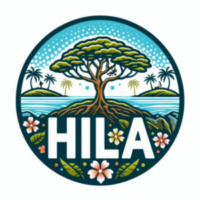Gary Eoff had a dream of creating an Hawaiian cultural center that included an educational garden of native Hawaiian plants as well as information about Polynesian navigational tools and a gathering place for the community. Along with Angel Pilago, the Kohanaiki ‘Ohana, and the Kohanaiki community, he started working on manifesting this vision in the late 1980s. It wasn’t until 2003 that collaborative efforts by numerous players produced a formal agreement.
Many community members were part of the original Kohanaiki ‘Ohana that formed in 1990 to protect the shoreline for the public and create an area for community use and cultural education at Kohanaiki. Though a Good Faith Agreement the County, the Community and Kohanaiki Shores forged a three-way partnership. The developer provided 100 acres of their beach front property for a County public shoreline beach park and included space for a cultural education center.
Though the collaboration took several years and many volunteer hours to develop, the result is a wonderful community resource. Reggie Lee, who is descended from long-time residents of Kohanaiki ahupua’a, works for Kohanaiki Shores today. As shoreline and public access manager he also serves as a cultural advisor and is directly involved in the day to day operation of the beach park and the educational area. Along with Kila Ynigues, who manages the maintenance of the anchialine ponds on the property and oversees other sustainability projects including the golf course, they represent the resort in the partnership. Plant expert, Mason Myrmo works as a part time gardener for the native plants.
More than twenty canoe plants were originally planted including food crops as well as those with particular cultural uses, especially ones used for cordage. Being mindful of the sea level location of the garden required selecting plants that were salt tolerant, would grow well in dry, sandy soil and could stand up to the heat at that elevation. A large seventeen foot replica of a star compass near the garden adds to the cultural education goal. This lovely stone piece helps describe how the early Polynesians navigated using celestial bodies as well as ocean swells to arrive in these Hawaiian Islands.
In addition to these cultural features the space also includes a large traditional style halau that is a perfect spot for classes, meetings or hula rehearsals. Use of Ka Hale Wa’a o Kohanaiki is open to the public by request and with a reservation. An application for its use can be found at https://ohana-o-kohanaike.org/halau-use-application/.
Many volunteers offer their services to teach classes at the site. A list of topics and teachers can be found at https://ohana-o-kohanaike.org/curriculum-info/. Students young and old can attend talks and classes on a diversity of topics including Hawaiian culture, celestial navigation, Hawaiian cordage and organic gardening. To find out more about the cultural events at the site, contact Reggie Lee at rlee@kohanaiki.com or call him at 987-7213.
During my recent visit to the native garden at Kohanaiki, Mason was happy to share some of the unique plants they are growing. Endemic species that originated here and nowhere else are represented as well as some indigenous plants that are native to Hawaii as well as other places. Many of the more than twenty canoe plants that were brought here centuries ago by the Polynesians are featured at Kohanaiki. These include specimens that could fulfill the voyagers’ needs for food, cordage, medicine, containers and fabric.
The plants are all installed in a well-designed space and with volunteer help the plants are well maintained. Among the efforts of the garden volunteers is a wonderful wooden trellis to support the heavy producing ipu gourd vines. In the raised beds rimmed with local rocks kalo (taro), ki (ti), and olena (turmeric) are growing well. Ko (sugar cane), ohe (bamboo), several native palm varieties and salt tolerant mai’a (bananas) grace the edges of the garden. A few useful plants have also been included. The native nanea is a legume with nitrogen-fixing properties and the Samoan dwarf coconut helps prevent erosion.
Despite the challenges of this ocean-side habitat, Gary, Mason and a crew of volunteers have chosen tolerant species and are doing an excellent job of maintaining them in this demonstration garden. Excellent signage throughout the site adds to the educational experience. Through Karen Eoff’s efforts, the county council was able to supply a contingency fund to have the signs made that included the English and Hawaiian names for the plants as well as their cultural uses.
A visit to the site is easy and definitely worthwhile. Taking the Kohanaiki Beach road to the south end and walking through the gate will bring you to the hale, the star compass and the educational garden. Go check it out.
Diana Duff is a plant adviser, educator and consultant living in a dryland forest north of Kailua-Kona.
